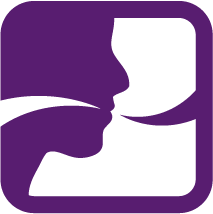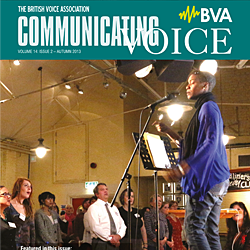About the Association
Archived newsletter articles
Working with Transexuals
By Christella Antoni
Therapists working in the field of gender dysphoria work in a challenging, specialist and relatively small field within the remit of speech and language therapy as a whole. The 'specialism ' is usually under the larger specialist field of 'Voice'.
However, in working with transgender individuals, working on voice is often just one aspect of our involvement, albeit a main aspect and often of prime concern to the patient.
More and more therapists around the country are now being called upon to work with the trans-gender/transexual client group. Referral rates are increasing, as is the scope of many of the voice posts, which may include a service to the transexual population.
An overview of transexualism
A transexual is a member of one sex biologically who feels and identifies as a member of the opposite sex. Psychiatric diagnosis of a Gender Dysphoric/ transexual / transgender individual is made after the conditions of schizophrenia, psychosis, homosexuality and transvestism have been excluded. There is a higher incidence of Male to Female (MTF) transexualis than Female to Male (FTM) transexuals. The ratio is approximately 4:1. However, the estimates of one per 100,000 males and one per 400,000 females (Pauly, 1968) are now considered by many to be very low.
Transexualism is not a new phenomenon. Various forms of gender dysphoria (dysphoria stems from the Greek meaning difficult to bear), and cross-gender behaviour have existed, cross-culturally, for centuries. The Gender scientist Harry Benjamin popularised the term 'transexual' with the publication of 'The Transexual Phenomenon' in 1966. The publication of Christine Jorgensen's autobiography in 1952, (one of Benjamin's former patients), served as a catalyst for many individuals who identified with her story to seek the kind of treatment she had received from Benjamin.
The treatment and management of transgender patients involves a variety of professional disciplines including Psychiatry, Urology, Endocrinology and Speech and Language Therapy. Although not all countries have Gender Identity Clinics, in some countries, progressive centres are established, for example, in the USA and the Netherlands. Since the 1990's, treatment has also become available in Japan and China. The largest treatment centre in the U.K. and internationally is the Gender Identity Clinic established in the 1970's. Charing Cross Hospital offers a national service but other local services exist around the country and offer a service on a smaller scale in areas such as Leeds, Edinburgh and Sheffield.
The MDT and aspects of intervention
An individual transitioning gender often finds themselves to be on a long and difficult road; one that will involve physical, emotional and practical adjustments. The medical model of treatment offered to these clients will bring them into contact with various gender specialists and clinicians which will include psychiatrists, and may include, urologists, endocrinologists, psychotherapists, Ear Nose and Throat surgeons and voice specialists.
Most typically, a client is referred via their GP to either a local psychiatrist or a psychiatrist at a specialised unit. A diagnosis of Gender Dysphoria is made after two separate psychiatrists have assessed the client. Following this, if there are no contra-indications, e.g., high blood pressure, the client is prescribed hormone treatment. In female to male transexuals, testosterone hormones promote hair growth. The androgen treatment they are prescribed leads to a thickening of their vocal folds and a corresponding shift in fundamental frequency resulting in a lower pitched voice. In male to female transexuals however, the oestrogen treatment they are given assists with aspects such as altering fat distribution and promoting breast growth. Oestrogen has no effect on the structure of the vocal cords and therefore no vocal changes occur in the client. The bulk of our work with this client group therefore is with Male to Female transexuals who wish to feminise their voice and communication.
The role of the voice specialist
Referral to Speech and Language Therapy to work primarily on feminising a client's voice is just one aspect of the client’s overall treatment. There is more tendency within the diagnosis of Gender Dysphoria to have an increased incidence of associated or other emotional health difficulties e.g., depression, confusion, isolation and this is hardly surprising but each client must be seen as individual and in most case in an evolving or varying state of transition.
For some people, the way they communicate and the way they sound is of prime concern: for others the focus may be primarily on physical presentation. Some transexuals are happy to present fairly androgenously while others are only content to present as unquestionably female. How a client sees himself or herself overall can be important to the outcome of therapy. Similarly, how strongly a person feels about their voice often dictates their level of motivation for therapy. Feminising a voice is difficult and involves a strong commitment on the part of both the therapist and the client.
For many clients, successfully feminising their voice proves to be unachievable or unimportant. As with all voice work, the starting point is a detailed initial assessment. The client's expectations of therapy must be clearly established as well as their ability to commit to treatment sessions and to practice. Base line measures of voice, both perceptual and objective should be taken in the first or second sessions if possible.
Many clients are now becoming interested in Crico-Thyroid Approximation Surgery to raise their overall pitch. This is often carried out in conjunction with a Chondroplasty procedure to reduce the laryngeal prominence. The client's interest in these procedures should also be established early on and the therapist will need to supply information and advice to clients considering this. It is important for clients to be aware that pitch raising surgery carried out without any prior speech and language therapy is likely to be less successful than if they have attended for a full course of treatment. Whilst this type of surgery is often successful in producing higher pitch for the patients, it can lead to increased incidence of dysphonia. Post-surgical follow up is therefore also heavily indicated.
A Voice Specialists input may feature around issues such as communication skills, communicative intent, non-verbal communication, e.g., use of gesture, and confidence. These issues, although more indirect, are no less important than the sound of a persons voice and can help aid in the clients overall passibility as female. Similarly, as the majority of Voice therapists/specialists are female, they often play a role in offering general advice to clients regarding their overall presentation. Generally this is client led as many clients establish a good rapport with their therapist and feel comfortable asking for advice and opinions. They may also be fairly isolated socially and therefore value an objective opinion.
Direct voice work includes hierarchically structured exercises in the areas of pitch, resonance, intonation and prosody. Some attention may also be indicated in areas such as use of language, volume and articulation. As the client gains increased ability in the above skills, they should be guided to combine them in the various exercises they are given. The aim of course, is to generalise the modified voice into their habitual voice with the goal of sounding convincingly female. Very often, a client achieves a reasonably feminine voice that passes successfully when a client presents in person but unsuccessfully when the visual clues are taken away, e.g., when the client uses the telephone. Telephone practice is therefore an important aspect of treatment but generally takes place in the latter stages of therapy, as it is a harder skill to acquire and requires increased confidence.
A therapist's involvement with a transgender individual is often longer than with a standard voice client. Whilst some services around the country only offer a short block of treatment e.g., 6 treatment sessions or less, from my experience this is generally insufficient to achieve a successful outcome for the client. Sometimes our intervention can be short, e.g. if a client has been reasonably successful at feminising their voice prior to attending for therapy. In other cases however, a far longer intervention takes place, e.g., if the client also has (or acquired) a dysphonic element to their voice or if they require input regarding general communication skills. The main bulk of my work with this client group is actually in helping clients to generalise their voice skills into everyday voice. More often than not, this proves far harder for the patient than acquiring the actual voice skills and in this way the work can prove to be similar to the kind of therapy I offer to the non-transgendered voice clients in my caseload.
Despite the challenges outlined above, (and several that I haven't mentioned!), working with transgender clients can be a truly rewarding and stimulating aspect of working within the field of voice. It allows for innovation and creativity but also requires patience, tolerance and genuine respect for human diversity of which gender variance is just one aspect. To the clients, the service we offer is invaluable. They frequently cite their concerns regarding their voice as paramount to their successful transition. In a recent audit carried out by the Gender Identity Clinic at Charing Cross Hospital, involving 100 clients, no dissatisfaction with speech and language therapy intervention was listed. I guess that, the 75 patients on my current caseload and the 7-month waiting list will keep me practising in the field for a good while longer...
Christella Antoni is a specialist speech and language therapist (Voice) who works at Charing Cross Hospital, London.
More archived content online
Disclaimer
Neither the British Voice Association nor the Editor can be held responsible for errors or any consequences arising from the use of information contained in its newsletters (or extracts from its newsletters published online); the views and opinions expressed do not necessarily reflect those of the British Voice Association (BVA) or the Editor, neither does the publication of advertisements constitute any endorsement by the BVA or Editor of any products or services featured.

 Join us Now!
Join us Now! our newsletter
our newsletter free voice care leaflets & information – download here
free voice care leaflets & information – download here Help our work by donating while you shop
Help our work by donating while you shop